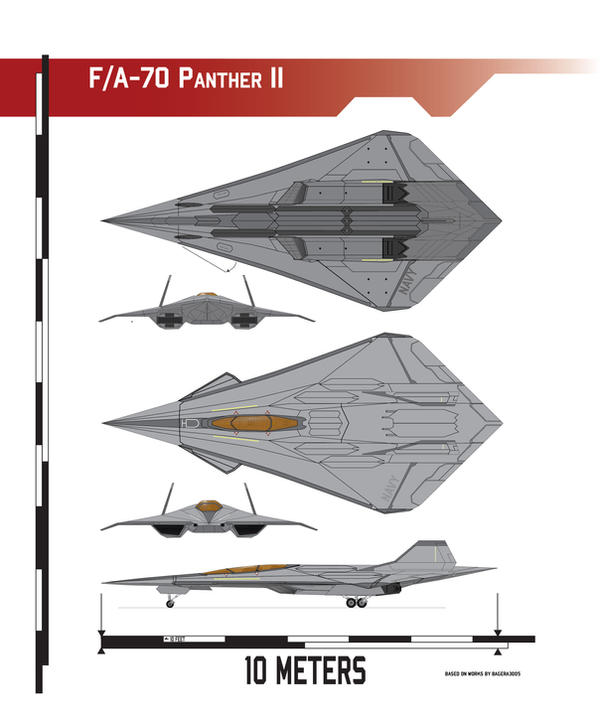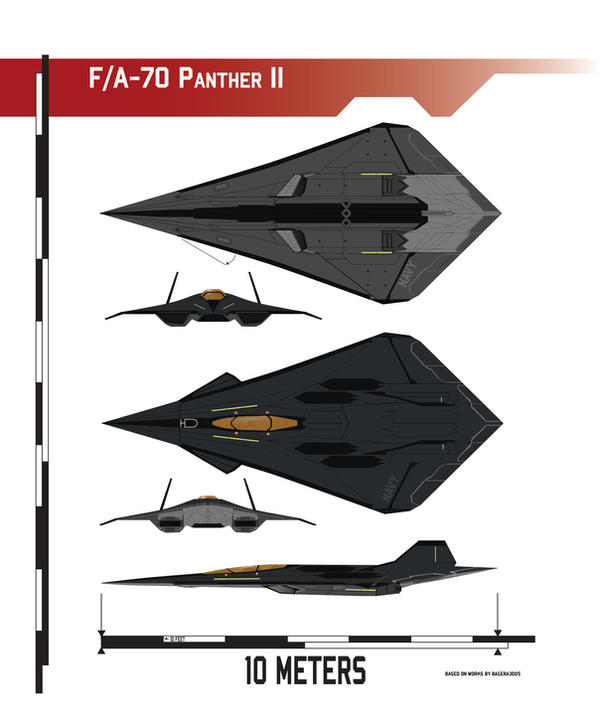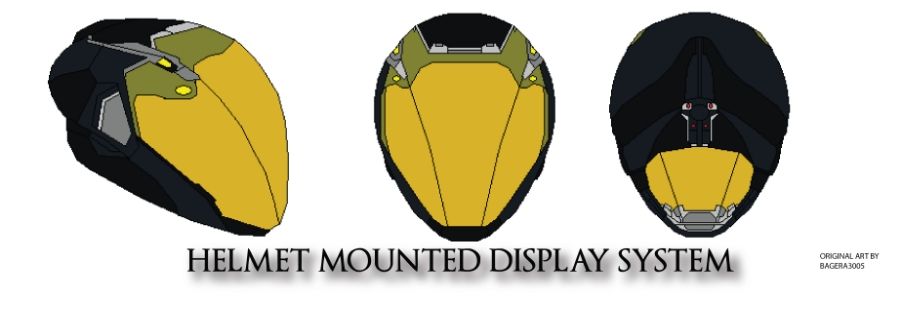F/A-70 Panther II
Art/text based off of works by bagera3005
PRICE
- Unit Cost: $90mil NSD (RESTRICTION LEVEL 3)
- DPR: $31bil NSD (RESTRICTION LEVEL 3)
Crew: 2 (Pilot/Flight Officer)
Length: 72 ft, 5in
Wingspan: 52 ft, 8 in
Height: 15 ft 11in
Wing Area: 1000 ft²
Empty weight: 30,000 lb
Loaded weight: 60,600 lb
Max takeoff weight: 65,000 lb
Powerplant: 2× G Pratt & Whitney YF220 , 65,000 lbf
Thrust vectoring: ±10° at 40° per second in pitch and yaw
Maximum speed: Mach 3.0
Cruise speed: Mach 1.9+
Combat radius: 1900-820 mi
Service ceiling: 75,000 ft (28.95600m)
Wing loading: 70 lb/ft² (456 kg/m²
Secondary Powerplant: 1× General Electric/Rolls-Royce F136 afterburning turbofan, >40,000 lbf (178 kN)
Lift fan (STOVL): 1× Rolls-Royce LiftSystem driven from either F135 or F136 power plant, 18,000 lbf (80 kN)
Internal fuel: 35.00 IB
Avionics:
AESA radar
Distributed Aperture System (DAS) missile warning system
Electronic Warfare Suite
Multifunction Advanced Data Link (MADL) communication system
Armament:
Guns: 2 × GAU-22/A 25 mm (0.984 in) cannon in internal mounted
Hardpoints: 4× external pylons on wings with a capacity of 30,000 lb ( internal mounted on Rotary Launcher Assembly (RLA)[37],
Internal: 12 air-to-air missiles, or 16 air-to-air missiles and 20 air-to-ground weapons.
External: 14 air-to-air missiles, or 4 air-to-ground weapons and 2 air-to-air missiles[40] with combinations for the following missiles:
2x Rear-Defense 10 Rounds, Guided Sabot.
Description
VSI Helmet-mounted display system
The FA-70 need not be physically pointing at its target for weapons to be successful. This is possible because of sensors that can track and target a nearby aircraft from any orientation, provide the information to the pilot through his helmet (and therefore visible no matter which way they are looking), and provide the seeker-head of a missile with sufficient information. Recent missile types provide a much greater ability to pursue a target regardless of the launch orientation, called "High Off-Boresight" capability, although the speed and direction in which the munition is launched affect the effective range of the weapon. Sensors use combined radio frequency and infra red (SAIRST) to continually track nearby aircraft while the pilot's helmet-mounted display system (HMDS) displays and selects targets. The helmet system replaces the display suite-mounted head-up display used in earlier fighters.
the FA-70's systems provide the edge in the "observe, orient, decide, and act" OODA loop; stealth and advanced sensors aid in observation (while being difficult to observe), automated target tracking helps in orientation, sensor fusion simplifies decision making, and the aircraft's controls allow action against targets without having to look away from them.
Fly-By-Light Advanced System
The Fly-By-Light Advanced System Hardware (FLASH) program is developing and demonstrating dual use fly-by-light hardware for flight control systems on military and commercial aircraft. Under the transport aircraft portion of this program, we and our industry teammates are demonstrating two representative fly-by-light systems. These fly-by-light demonstrations include a ground demonstration of a partial primary flight control system and a flight demonstration of an aileron trim control system. This paper describes these and discusses the dual use fly-by-light hardware developed for transport aircraft as well as the associated FLASH program demonstrations.
Gloved Close-coupled canard
In the close-coupled canard, the foreplane is located just above and forward of the main wing. At high angles of attack the canard surface directs airflow downwards over the wing, reducing turbulence which results in reduced drag and increased lift
Thrust Vector Control
Thrust Vector Control or Thrust Vectoring is a technology that deflects the mean flow of an engine jet from the centerline in order to transfer some force to the aimed axis. By that imbalance, a momentum is created and used to control the change of attitude of the aircraft. Among other things, thrust vectoring greatly improves maneuverability, even at high angles of attack or low speeds where conventional aerodynamic control surfaces lose all effectiveness. Thrust Vector Control is currently achieved by complex arrays of mechanical actuators capable of modifying the geometry of the nozzle and thus defect the flow. This variable geometry greatly increases weight and maintenance to the engine, and therefore limits the benefits from vectoring the thrust.
Floating Cockpit
The Floating Cockpit is a technology in which the body of the cockpit suspended in a shock-absorbent gel which hardens on impact. This design improves the ability of the cockpit to take a large shock, i.e. a missile to the aircraft body, without endangering the pilot.
Ejection Pod
In additional to traditional ejection, the pilot can choose to eject the cockpit itself away from the fuselage. During this, the additional weight being thrown out of the aircraft forces the nose down, directing the aircraft away from the cockpit as it is propelled away as well, greatly increasing the survival chance of the pilot. The cockpit can either then be discarded or ridden all the way down with a pair of parachutes, one on either end, ensuring a gentle ride.



